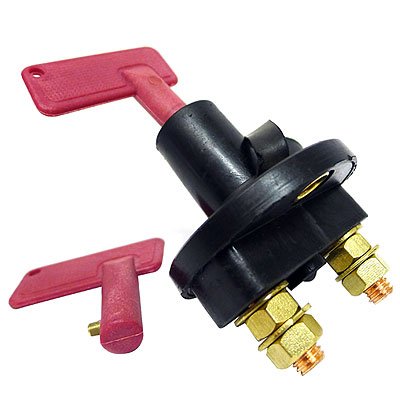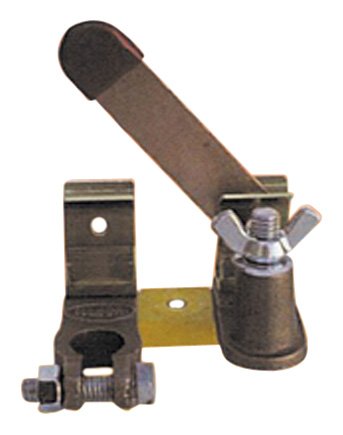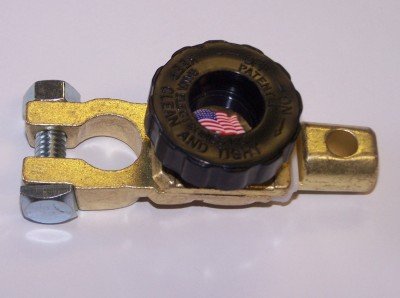The title of today's post - "Safety Fast!" - comes from Triumph's arch-rival in the British sportscar world, MG. I've always thought it was a pretty clever slogan. Performance means safety, they're saying, and they're right. It's a philosophy that SAAB used to counter Volvo's "Swedish tank" reputation back in the 1980's: the safest accident to be in is the one that never happens, because you had the visibility, agility, power and/or braking to avoid it.
To that end, today's work session focused on a couple of safety-critical systems: brakes and steering.
Tie Rod Ends
The tie rods connect the steering rack to the front wheel assemblies. The rack slides sideways as the steering wheel is turned; the tie rods translate that horizontal motion into steering motion by push-pulling the hub assemblies, which pivot on the vertical axis, so that the wheels point in your new, desired direction.
The steering rack assembly is mounted firmly to the chassis, while the wheels need to be able to travel up and down on the suspension, so the tie rods incorporate a ball-and-socket joint at either end to permit that movement. The joints on the outer end of the tie rods are removable, because they tend to get worn and damaged by road debris, heat from the nearby braking surfaces, and the stresses put on them by the steering forces. Besides, threading the tie rod ends along the tie rods provides the adjustment needed to perform front end alignment.
 |
This old tie rod end was an accident waiting to happen.
Scary! |
The tie rod end is protected by a rubber boot to keep the moving parts clean and greasy, the way they ought to be. Once a tie rod end's boot fails, the surfaces are subject to grit, water, and gradual loss of grease. Eventually, the cup that keeps the ball from popping out of the socket fails. When this happens, you'll suddenly lose steering control on that side just after hitting a bump; the two front wheels will point in different directions, and the car will probably end up going straight into whatever is directly ahead, possibly shedding parts as it does so.
Personally, I hope never to find out what it's like to be in a car when that's happening. So when I inspected the tie rod ends and found one boot entirely missing, with damage visible to the ball and socket beneath, I figured now was a great time to pop in some new ones.
Luckily, the P.O. had provided spare tie rod ends, as well as spare boots to protect the inner ends of the tie rods.
 |
| New boot and tie rod end in place. |
It's a simple enough job. The tie rod ends themselves are sort of press fit into the tie rod levers on the hubs. Removing them requires a "pickle fork" - the clever colloquial name for the tie rod end remover. But I have one of those, and was able to free things up pretty easily.
Once the old tie rod ends are removed, you can slide the old boots off, slide the new boots on, thread on the replacement tie rod end, and tighten everything down. You may need to perform an alignment, but that's the extent of the tricky stuff.
Well, except for the fact that the boots are tight, and end up all greasy when you're trying to put them on. I couldn't for the life of me figure out how to get the things seated. Vic from the Triumph Experience forum to the rescue: soak the end of the boot in boiling water for a few minutes, so that it will be pliable. Then you'll be able to stretch it into place better. I found that, even with the boiling water trick, it took 6 or 8 tries to get it. But get it I did, eventually.
Then it was a simple matter of getting the new tie rod ends installed. I showed my boys how to use a torque wrench while we were at it.
The alignment will wait until we're closer to getting this thing on the road. But hey, don't let me forget it, okay?
Front Brakes
 |
Both brake calipers will get wire brushed clean,
overhauled, and painted with caliper paint. |
When the P.O. sold me the car, he described it as "needing rear brakes." I took this to mean that the front brakes were fine. But the fact is, they look pretty rough. The pads looked okay, but the rubber brake hoses are cracked and aged, and the steel brake pipes are rusty. The disc calipers look weathered, but there were no obvious signs of fluid leaks.
I'm sure there are cars on the road in similar condition, but it would be criminal not to fix the rusty and cracked hydraulic lines while I've got the brake master cylinder out. Luckily, the P.O. provided an expensive set of copper brake pipes with the car.
 |
The brake discs don't show much wear, so I
should be able to just get them machined smooth and reinstall them. |
So I disconnected the hoses and took a crack at getting the hard lines free, too. That might take some doing, as the hard lines are corroded and pretty stuck in their T fittings. For now, I soaked 'em in WD-40 and let it start to penetrate.
I'll gradually remove the rusty hard lines and install their shiny copper replacements as I'm able to break things loose. Meanwhile, I pulled the calipers off, so while I'm waiting for the WD-40 to do its job, I can clean, overhaul, and paint the calipers.
And I'll try to get the rotors machined, if they are within specification, or replace them if they are not. And while I'm doing that I might as well replace the front wheel bearings. And....
That "While I'm at it" phrase is a dangerous one, because "while I'm at it" I might as well strip everything down to bare metal, weld in new rocker panels and floors, and overhaul the engine. We're trying not to end up there. But brakes and tie rod ends seem like a no-brainer: I don't want to get this thing running only to run it into a bridge abutment when some critical safety system fails.














